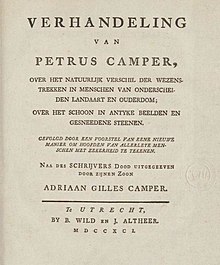Facial angle

1791 posthumous edition by Camper's son
|
|
| Author | Petrus Camper |
|---|---|
| Original title | Report of the content of two lectures (Dutch: Berigt van den zaaklyken inhoud van twee lessen) |
| Illustrator | Petrus Camper, engraved by Reinier Vinkeles |
| Country | Netherlands |
| Language | Dutch, French |
| Subject | Facial angles in portraiture through the centuries |
| Genre | Art History, Drawing lessons |
| Publisher | R. Wild & J. Altheer, Utrecht |
|
Publication date
|
1770, 1791 (engravings) |
| Media type | Print (Hardcover), Online version of original text available from the DBNL and Google books |
| Pages | Original is a report of a few pages; the posthumous book is longer with notes and engravings |
Facial Angles refers to the content of two lectures on this subject by the Amsterdam professor of anatomy Petrus Camper on the 1st and 8 August in 1770 to the Amsterdam Drawing Academy called the Teken-akademie.
Camper was a competent artist and draughtsman who had taken drawing lessons from Carel de Moor and his son Carel Isaak de Moor in Leiden, and whose own pupils had been Martin van Marum, Johannes le Francq van Berkhey, and Wibrand Veltman. His broad interest in the natural sciences had led him to anatomy and he was praelector of the Amsterdam Surgeon's guild, a respected position that placed him also in the Amsterdam vroedschap or regency. He had published papers and lectures on a variety of anatomy subjects, and came to the lectures with several engraved examples of popular art that he wanted to discuss on the basis of anatomy. He brought with him the skull of a baby, child, man, and elderly man, and two large canvasses with sketched drawings of the mathematical dimensions of the human head.
Camper's main points in his first lecture were that classical drawing lessons from the time of Vitruvius, including the teachings of Dürer and Perreault, were based on an incorrect assumption that the human head was oval at all ages, and he proceeded to prove this with his dimensions of the skulls. He also remarked that none of the various humans of modern "nations" such as Europeans, Moors or Kalmyk people adhere to the classic form of head so remarkable in Grecian sculpture. The travelogues of Plinius and de Buffon made mention of practises in infancy which caused these national characteristics, such as Chinese women pulling their eye lids to the sides, or African Moors pressing their noses flat, or Europeans pressing their ears flat with caps tied tight. Camper claimed this was all nonsense and the forms of people's faces (and their skulls) were related to their living environments. He then proceeded to demonstrate on his sketches, by shortening the chin he could transform a likeness of a man to an old man, and by adjusting the facial angle, he changed a Moor into a European, and he was so successful in this demonstration with a few lines of chalk, that the hall cheered.
...
Wikipedia
